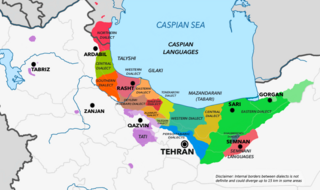
Ethnologue: Languages of the World is an annual reference publication in print and online that provides statistics and other information on the living languages of the world. It is the world's most comprehensive catalogue of languages. It was first issued in 1951, and is now published by SIL International, an American Christian non-profit organization.

A language family is a group of languages related through descent from a common ancestral language or parental language, called the proto-language of that family. The term "family" reflects the tree model of language origination in historical linguistics, which makes use of a metaphor comparing languages to people in a biological family tree, or in a subsequent modification, to species in a phylogenetic tree of evolutionary taxonomy. Linguists therefore describe the daughter languages within a language family as being genetically related.

Semnan Province is one of the 31 provinces of Iran. It is in the north of the country, with its center and capital in the city of Semnan. The province of Semnan covers an area of 96,816 square kilometers and stretches along the Alborz mountain range, bordering on Dasht-e Kavir desert in its southern parts.
The Pamir languages are an areal group of the Eastern Iranian languages, spoken by numerous people in the Pamir Mountains, primarily along the Panj River and its tributaries.

Italo-Western is, in some classifications, the largest branch of the Romance languages. It comprises two of the branches of Romance languages: Italo-Dalmatian and Western Romance. It excludes the Sardinian language and Eastern Romance.
The Parthian language, also known as Arsacid Pahlavi and Pahlawānīg, is an extinct ancient Northwestern Iranian language once spoken in Parthia, a region situated in present-day northeastern Iran and Turkmenistan. Parthian was the language of state of the Arsacid Parthian Empire, as well as of its eponymous branches of the Arsacid dynasty of Armenia, Arsacid dynasty of Iberia, and the Arsacid dynasty of Caucasian Albania.

Mazandarani (مازندرانی), or Tabari (طبری), is an Iranian language of the Northwestern branch spoken by the Mazandarani people. As of 2019, there were 2 million native speakers. As a member of the Northwestern branch, etymologically speaking, it is rather closely related to Gilaki and also related to Persian, which belongs to the Southwestern branch. Though the Persian language has influenced Mazandarani to a great extent, Mazandarani still survives as an independent language with a northwestern Iranian origin.
The Republic of Vanuatu has the world's highest linguistic density per capita.

The Western Iranic languages are a branch of the Iranic languages, attested from the time of Old Persian and Median.

Sangsari or Sangisari is an Iranian language spoken mainly in the Semnan and Tehran provinces of Iran, especially in the Sangesar town and in several surrounding villages. Sangsari is included in the Semnani group of Northwestern Iranian languages that also includes Lasgerdi, Semnani, and Sorkhei. There are around 50,000 Sangsari speakers.

The official language of Greece is Greek, spoken by 99% of the population. In addition, a number of non-official, minority languages and some Greek dialects are spoken as well. The most common foreign languages learned by Greeks are English, German, French and Italian.

The Uwa language, Uw Cuwa, commonly known as Tunebo, is a Chibchan language spoken by between 1,800 and 3,600 of the Uwa people of Colombia, out of a total population of about 7,000.

The Nambikwaran languages are a language family of half a dozen languages, all spoken in the state of Mato Grosso in Brazil. They have traditionally been considered dialects of a single language, but at least three of them are mutually unintelligible.

Sorkheh is a city in and the capital of Sorkheh County, in Semnan Province, Iran. At the 2006 census, its population was 9,062, in 2,686 families. Sorkhei, a Semnani Persian dialect and language, is still spoken by some of its inhabitants.

Semnani is one of the local languages of the Semnan Province of Iran. Despite the common misconception that Semnani is a Persian dialect, the language belongs to the Northwestern branch of the Western Iranian languages. Like other Caspian languages, it bears some resemblance to the Old Iranian Median language and was influenced by Parthian in a later process.
The Hill Nubian languages, also called Kordofan Nubian, are a dialect continuum of Nubian languages spoken by the Hill Nubians in the northern Nuba Mountains of Sudan.
The Tat people of Iran are an Iranian people living in northern Iran, especially in Qazvin province.

Sorkhei is a Western Iranian language. It is spoken in village of Sorkheh in Semnan Province in northwestern Iran.











